Difference between revisions of "Baldax"
(Took italics out of captions; present tense in a few places; =Notes= not =references=, other minor changes) |
m (Spacing out a bit, margins on some of the pictures) |
||
| Line 1: | Line 1: | ||
| + | __NOTOC__ | ||
| + | <div class="floatright plainlinks" style="margin:0px 0px 15px 15px;"> | ||
{{Flickr_image | {{Flickr_image | ||
|image_source= http://www.flickr.com/photos/mario_groleau/2296322065/in/pool-camerawiki | |image_source= http://www.flickr.com/photos/mario_groleau/2296322065/in/pool-camerawiki | ||
|image= http://farm4.static.flickr.com/3215/2296322065_aa848124b2_m.jpg | |image= http://farm4.static.flickr.com/3215/2296322065_aa848124b2_m.jpg | ||
| − | |image_align= | + | |image_align= |
|image_text= | |image_text= | ||
|image_by= Mario Groleau | |image_by= Mario Groleau | ||
|image_rights= nc | |image_rights= nc | ||
}} | }} | ||
| + | </div> | ||
The '''Baldax''' is a series of folding cameras for 4.5×6 and 6×6 cm pictures, made by the German company [[Balda]]. | The '''Baldax''' is a series of folding cameras for 4.5×6 and 6×6 cm pictures, made by the German company [[Balda]]. | ||
| + | <br style="clear:right;"/> | ||
== Prewar models == | == Prewar models == | ||
| + | <div class="floatleft plainlinks" style="margin:0px 25px 15px 0px;"> | ||
{{Flickr_image | {{Flickr_image | ||
|image_source= http://www.flickr.com/photos/ccastor/4281514613/in/pool-camerawiki | |image_source= http://www.flickr.com/photos/ccastor/4281514613/in/pool-camerawiki | ||
|image= http://farm3.static.flickr.com/2770/4281514613_dccd1f856f_m.jpg | |image= http://farm3.static.flickr.com/2770/4281514613_dccd1f856f_m.jpg | ||
| − | |image_align= | + | |image_align= |
|image_text= Robra, name variant of the<br/>prewar Baldax | |image_text= Robra, name variant of the<br/>prewar Baldax | ||
|image_by= .Castor | |image_by= .Castor | ||
|image_rights= wp | |image_rights= wp | ||
}} | }} | ||
| − | + | </div> | |
The prewar '''Baldax''' was made throughout the 1930s in three main variants: a '''4.5×6 small model''' for #00 shutter size, a '''4.5×6 large model''' for #0 shutter size and a '''6×6 model''' (#0 size). All the Baldax cameras have solidly built diagonal struts, with a characteristic shape, wider at the base. Some have a folding optical finder and others a tubular one. The body shape evolved during the period of production. | The prewar '''Baldax''' was made throughout the 1930s in three main variants: a '''4.5×6 small model''' for #00 shutter size, a '''4.5×6 large model''' for #0 shutter size and a '''6×6 model''' (#0 size). All the Baldax cameras have solidly built diagonal struts, with a characteristic shape, wider at the base. Some have a folding optical finder and others a tubular one. The body shape evolved during the period of production. | ||
| Line 25: | Line 30: | ||
In Japan it was copied by [[Proud]] as the [[Semi Proud]], which was in turn the basis of the [[Semi Olympus]], the first [[Olympus]] camera. [[Motodori]] made a full line of copies of the 4.5×6 model, with the [[Semi Lester]], [[Victor folders|Semi Victor]], [[Condor folders|Semi Condor]] and early [[Zeitax]], and copied the 6×6 model for the [[Victor folders|Victor Six]] and [[Condor folders|Condor Six]]. Other Japanese copies were the early [[Semi Rody]] made by [[Shibayama]], the [[Kelly]] sold by [[Miyoshi]], the [[Semi Rosen|Semi Rosen III]] sold by [[Ōsawa]] and the [[Semi Adler and Adler III|Semi Adler, Adler III]], [[Adler C]] and [[Heil]] sold by [[Ricoh|Riken]]. Some of these cameras were simply name variants of each other. | In Japan it was copied by [[Proud]] as the [[Semi Proud]], which was in turn the basis of the [[Semi Olympus]], the first [[Olympus]] camera. [[Motodori]] made a full line of copies of the 4.5×6 model, with the [[Semi Lester]], [[Victor folders|Semi Victor]], [[Condor folders|Semi Condor]] and early [[Zeitax]], and copied the 6×6 model for the [[Victor folders|Victor Six]] and [[Condor folders|Condor Six]]. Other Japanese copies were the early [[Semi Rody]] made by [[Shibayama]], the [[Kelly]] sold by [[Miyoshi]], the [[Semi Rosen|Semi Rosen III]] sold by [[Ōsawa]] and the [[Semi Adler and Adler III|Semi Adler, Adler III]], [[Adler C]] and [[Heil]] sold by [[Ricoh|Riken]]. Some of these cameras were simply name variants of each other. | ||
| − | + | <br style="clear:both;"/> | |
== Postwar models == | == Postwar models == | ||
| Line 35: | Line 40: | ||
| Super Baldax, Baldanar 80/3.5. <small>Pictures by {{image author|eBayer Yalluflex}}.</small> {{with permission}} | | Super Baldax, Baldanar 80/3.5. <small>Pictures by {{image author|eBayer Yalluflex}}.</small> {{with permission}} | ||
|} | |} | ||
| − | |||
The postwar '''Baldax''' is a development of the prewar model, sold at the beginning of the 1950s by the West German company Balda Bünde. It exists only in a 6×6 version and has a top housing incorporating the viewfinder and an exposure counter. The '''Super Baldax''' of the same time is the same camera with a [[coupled rangefinder]]. The [[Baldix|Baldix, Mess-Baldix and Baldi 29]] were derived from the postwar Baldax. | The postwar '''Baldax''' is a development of the prewar model, sold at the beginning of the 1950s by the West German company Balda Bünde. It exists only in a 6×6 version and has a top housing incorporating the viewfinder and an exposure counter. The '''Super Baldax''' of the same time is the same camera with a [[coupled rangefinder]]. The [[Baldix|Baldix, Mess-Baldix and Baldi 29]] were derived from the postwar Baldax. | ||
| Line 51: | Line 55: | ||
|- | |- | ||
|} | |} | ||
| + | <br style="clear:both;"/> | ||
| + | |||
==Notes== | ==Notes== | ||
| − | + | {| class="plainlinks floatright" style="margin:0px 0px 15px 15px;text-align: center;" | |
| − | |||
| − | {| class="plainlinks floatright" style="text-align: center;" | ||
|- | |- | ||
| [http://www.flickr.com/photos/mario_groleau/2297118382/in/pool-camerawiki http://farm4.static.flickr.com/3066/2297118382_8bd8b76898_m.jpg] | | [http://www.flickr.com/photos/mario_groleau/2297118382/in/pool-camerawiki http://farm4.static.flickr.com/3066/2297118382_8bd8b76898_m.jpg] | ||
| Line 63: | Line 67: | ||
| <small>Pictures by {{image author|Mario Groleau}}.</small> {{non-commercial}} | | <small>Pictures by {{image author|Mario Groleau}}.</small> {{non-commercial}} | ||
|} | |} | ||
| + | <references/> | ||
| + | |||
| + | == Links == | ||
In English: | In English: | ||
* [http://www.certo6.com/cam/balda.html Super Baldax] at [http://www.certo6.com/ Vintage Folding Cameras] | * [http://www.certo6.com/cam/balda.html Super Baldax] at [http://www.certo6.com/ Vintage Folding Cameras] | ||
Revision as of 11:11, 27 June 2012
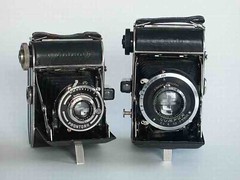
|
| image by Mario Groleau (Image rights) |
The Baldax is a series of folding cameras for 4.5×6 and 6×6 cm pictures, made by the German company Balda.
Prewar models
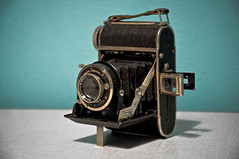
|
| Robra, name variant of the prewar Baldax image by .Castor (Image rights) |
The prewar Baldax was made throughout the 1930s in three main variants: a 4.5×6 small model for #00 shutter size, a 4.5×6 large model for #0 shutter size and a 6×6 model (#0 size). All the Baldax cameras have solidly built diagonal struts, with a characteristic shape, wider at the base. Some have a folding optical finder and others a tubular one. The body shape evolved during the period of production.
The Baldax was also sold under various distributor names, like the Lisette by Porst, the Noris by Müller, the Ysette 4.5×6 and 6×6 by Rodenstock (equipped with Trinar lenses) or the Robra by Josef Rodenstock.[1] It was also the basis of the Plaubel Roll-Op models, both in 4.5×6 and in 6×6 versions.
In Japan it was copied by Proud as the Semi Proud, which was in turn the basis of the Semi Olympus, the first Olympus camera. Motodori made a full line of copies of the 4.5×6 model, with the Semi Lester, Semi Victor, Semi Condor and early Zeitax, and copied the 6×6 model for the Victor Six and Condor Six. Other Japanese copies were the early Semi Rody made by Shibayama, the Kelly sold by Miyoshi, the Semi Rosen III sold by Ōsawa and the Semi Adler, Adler III, Adler C and Heil sold by Riken. Some of these cameras were simply name variants of each other.
Postwar models
 
|
  
|
| Super Baldax, Baldanar 80/3.5. Pictures by eBayer Yalluflex. (Image rights) |
The postwar Baldax is a development of the prewar model, sold at the beginning of the 1950s by the West German company Balda Bünde. It exists only in a 6×6 version and has a top housing incorporating the viewfinder and an exposure counter. The Super Baldax of the same time is the same camera with a coupled rangefinder. The Baldix, Mess-Baldix and Baldi 29 were derived from the postwar Baldax.
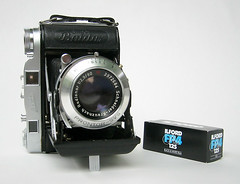
|
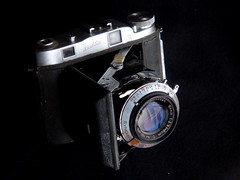
| |
| Super Baldax, with Radionar 80/2.9. Picture by Voxphoto. (Image rights) |
Super Baldax, with Ennit 8cm f/2.8. Picture by Paulo Moreira. (Image rights) |
Notes
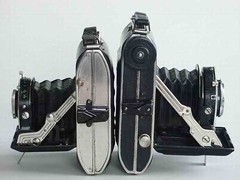
|

|
| Pictures by Mario Groleau. (Image rights) |
- ↑ McKeown, James M. and Joan C. McKeown's Price Guide to Antique and Classic Cameras, 12th Edition, 2005-2006. USA, Centennial Photo Service, 2004. ISBN 0-931838-40-1 (hardcover). ISBN 0-931838-41-X (softcover). pp799 and 848.
Links
In English:
- Super Baldax at Vintage Folding Cameras
- List of Balda instruction manuals at Orphancameras.com
In French:
- Baldax at Mario Groleau's website
- Baldax at Sylvain Halgand's www.collection-appareils.fr
- Me and Balda Baldax at Classic Cameras by RaúlM.
- Balda Super Baldax Review at Thorley Photographics by Thorley Bros
In Japanese:
- Baldax at Puppy's Island, with sample pictures
- Baldax at Minosan's blog
- Baldax at Kume's camera site